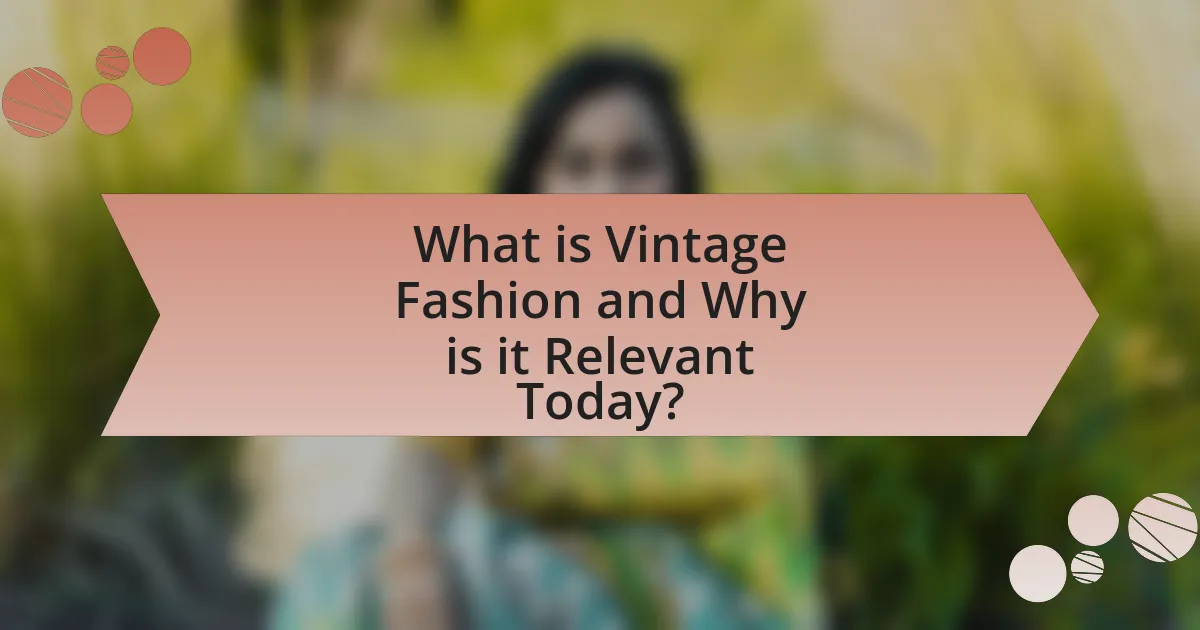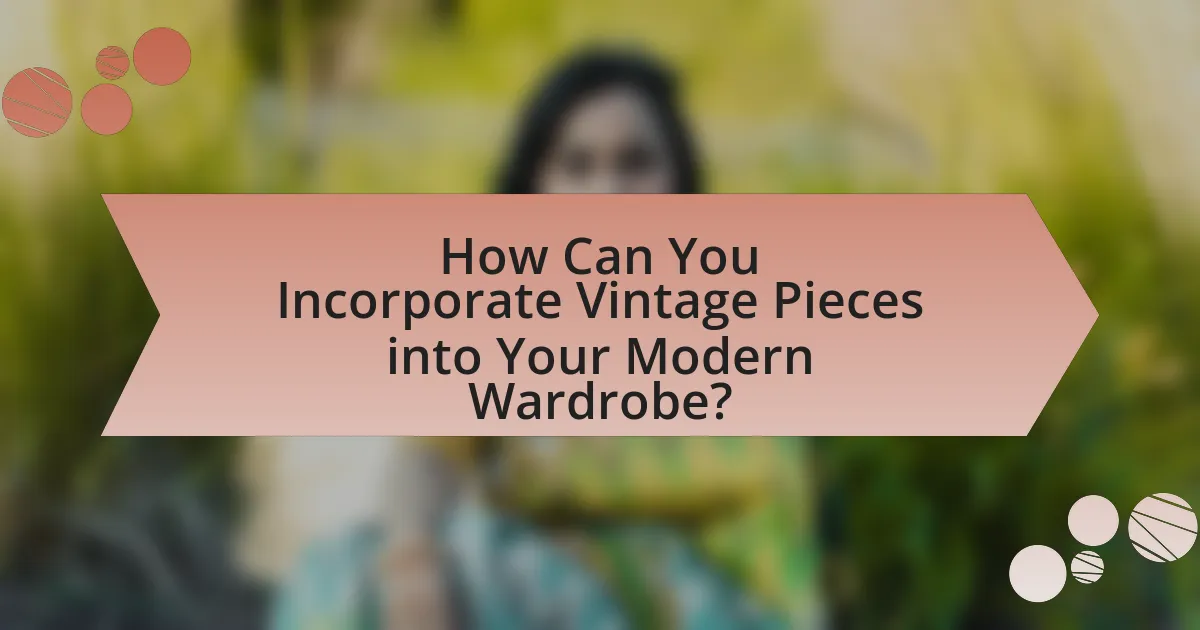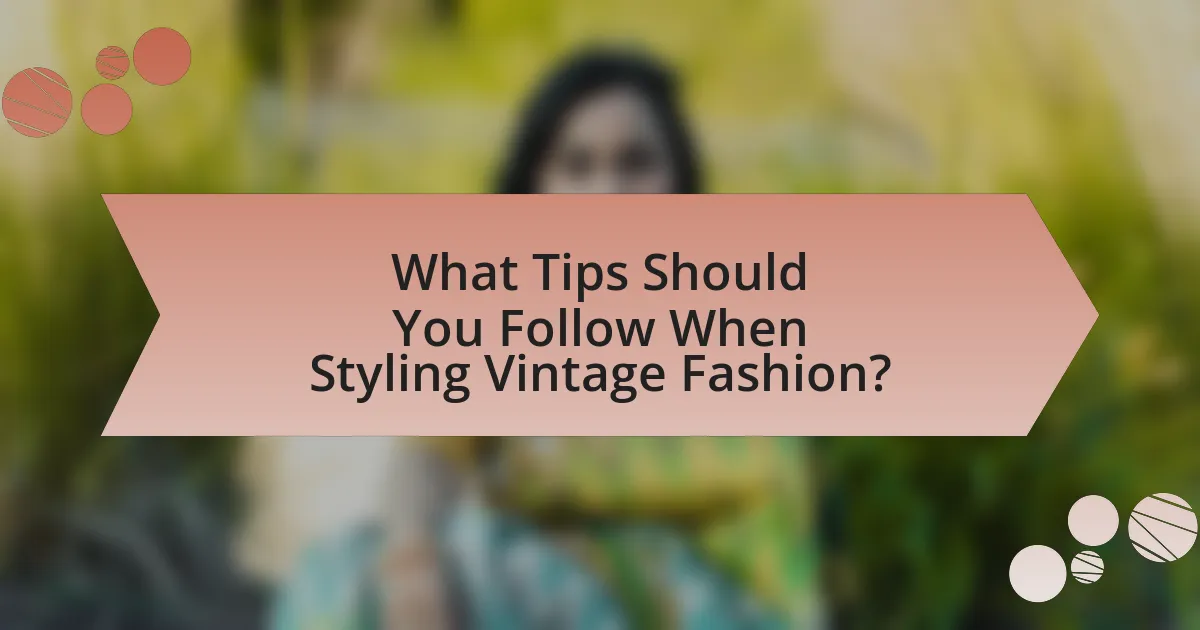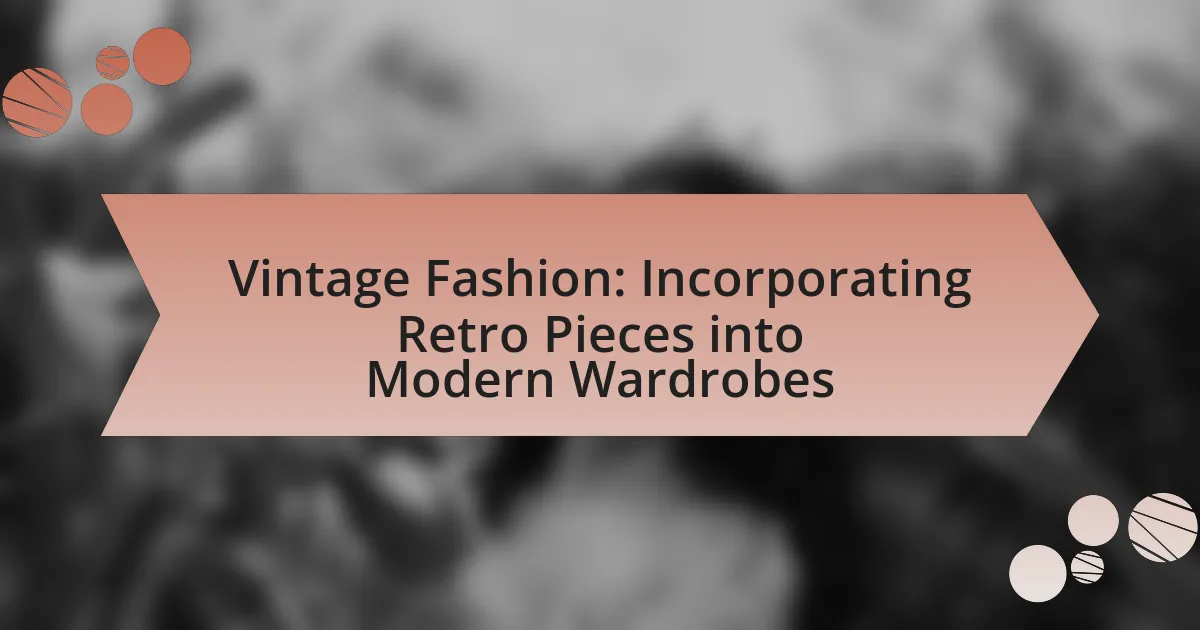Vintage fashion encompasses clothing and accessories that are at least 20 years old, reflecting distinctive styles from various historical periods. Its growing relevance today is driven by a cultural shift towards sustainability and individuality, with the secondhand market projected to reach $64 billion by 2024. The article explores the definition of vintage fashion, its historical context, and the differences between vintage and retro styles. It also discusses the increasing popularity of vintage pieces in modern wardrobes, the influence of sustainability on consumer choices, and practical tips for incorporating vintage items into contemporary outfits. Additionally, it highlights where to find authentic vintage pieces and offers styling advice to ensure a cohesive look.

What is Vintage Fashion and Why is it Relevant Today?
Vintage fashion refers to clothing and accessories that are at least 20 years old, often characterized by distinctive styles from past decades. Its relevance today stems from a growing interest in sustainability, as consumers increasingly seek unique, high-quality pieces that reduce fast fashion’s environmental impact. According to a 2021 report by ThredUp, the secondhand market is projected to reach $64 billion by 2024, highlighting the rising demand for vintage items. This trend reflects a cultural shift towards valuing individuality and historical significance in fashion, making vintage pieces not only stylish but also a conscious choice for modern wardrobes.
How do we define vintage fashion?
Vintage fashion is defined as clothing and accessories that are at least 20 years old, often reflecting the styles and trends of a specific era. This classification is based on the historical significance and aesthetic appeal of garments, which are typically sought after for their unique designs and craftsmanship. For example, items from the 1920s Art Deco period or the 1970s bohemian style are considered vintage and are valued for their cultural impact and nostalgic qualities.
What time periods are considered vintage in fashion?
Vintage fashion typically refers to clothing and accessories from the 1920s to the 1990s. This range is defined by the fashion industry’s recognition of styles that are at least 20 years old, with the 1920s marking the beginning of modern fashion as we know it today. The 1990s is often included as the endpoint for vintage, as items from this decade are now considered retro and are increasingly sought after in contemporary fashion.
How does vintage fashion differ from retro fashion?
Vintage fashion refers to clothing that is at least 20 years old and represents the styles and trends of a specific historical period, while retro fashion is characterized by modern clothing that imitates or is inspired by styles from the past, typically from the 1950s to the 1980s. Vintage pieces are authentic items from the past, often sought after for their unique craftsmanship and historical significance, whereas retro items are newly made but designed to evoke nostalgia for earlier fashion eras. This distinction is important as it highlights the authenticity of vintage clothing compared to the contemporary reinterpretation found in retro fashion.
Why has vintage fashion gained popularity in modern wardrobes?
Vintage fashion has gained popularity in modern wardrobes due to a growing desire for individuality and sustainability. Consumers increasingly seek unique clothing that sets them apart from mass-produced fast fashion, leading to a resurgence in the appreciation for vintage pieces. Additionally, the environmental impact of the fashion industry has prompted many to opt for second-hand clothing, as it reduces waste and promotes recycling. According to a report by ThredUp, the second-hand market is projected to reach $64 billion by 2024, highlighting the significant shift towards vintage and pre-owned fashion. This trend reflects a broader cultural movement valuing authenticity and environmental consciousness in personal style choices.
What cultural factors contribute to the resurgence of vintage fashion?
The resurgence of vintage fashion is primarily driven by a cultural shift towards sustainability and individuality. As consumers become increasingly aware of the environmental impact of fast fashion, they seek alternatives that promote eco-friendliness, with vintage clothing being a sustainable option due to its reuse and recycling of existing garments. Additionally, the desire for unique self-expression in a world of mass production leads individuals to vintage fashion, which offers distinctive styles that reflect personal identity. This trend is supported by social media platforms, where influencers and fashion enthusiasts showcase vintage pieces, further popularizing the aesthetic and encouraging a broader acceptance of retro styles in contemporary wardrobes.
How does sustainability influence the appeal of vintage clothing?
Sustainability significantly enhances the appeal of vintage clothing by promoting eco-friendly practices and reducing waste. Consumers increasingly value vintage pieces as a sustainable alternative to fast fashion, which contributes to environmental degradation. According to a 2021 report by the Ellen MacArthur Foundation, the fashion industry is responsible for 10% of global carbon emissions, highlighting the need for sustainable choices. Vintage clothing, by reusing existing garments, minimizes the demand for new production and helps decrease the overall carbon footprint. This alignment with sustainable values resonates with environmentally conscious consumers, making vintage clothing more attractive in the modern market.

How Can You Incorporate Vintage Pieces into Your Modern Wardrobe?
Incorporating vintage pieces into a modern wardrobe can be achieved by blending them with contemporary items to create a balanced look. For example, pairing a vintage blazer with modern jeans and a simple t-shirt can create a stylish contrast that highlights both the vintage and modern elements. Additionally, accessorizing with vintage jewelry or bags can elevate an outfit without overwhelming it. Historical fashion trends show that mixing styles has been popular since the 1920s, indicating that this approach is both timeless and effective.
What are the best ways to mix vintage and contemporary styles?
The best ways to mix vintage and contemporary styles include selecting key vintage pieces that serve as statement items, pairing them with modern basics for balance, and maintaining a cohesive color palette. For instance, a vintage dress can be complemented with contemporary accessories like a sleek handbag or modern footwear, creating a harmonious look. Additionally, layering vintage outerwear over contemporary outfits can add depth and character. This approach is supported by fashion experts who emphasize the importance of contrast and balance in style, allowing for personal expression while ensuring that the overall aesthetic remains polished and intentional.
How can you balance vintage pieces with modern trends?
To balance vintage pieces with modern trends, combine one or two vintage items with contemporary clothing to create a cohesive look. This approach allows the vintage pieces to stand out while ensuring the overall outfit feels current. For instance, pairing a vintage blazer with modern jeans and a simple top can create a stylish contrast. Additionally, incorporating modern accessories, such as trendy shoes or bags, can further harmonize the vintage elements with contemporary fashion. This method is effective because it leverages the unique character of vintage items while grounding the outfit in modern aesthetics, making it visually appealing and relevant.
What accessories work well with vintage clothing?
Accessories that work well with vintage clothing include statement jewelry, retro handbags, and classic hats. Statement jewelry, such as bold earrings or layered necklaces, enhances the unique aesthetic of vintage outfits. Retro handbags, particularly those from the 1950s to 1970s, complement the style and add a touch of authenticity. Classic hats, like fedoras or cloches, not only provide a vintage flair but also serve practical purposes. These accessories are widely recognized for their ability to elevate vintage fashion, as they align with historical trends and styles, making them ideal choices for enhancing retro looks.
Where can you find authentic vintage pieces?
Authentic vintage pieces can be found at specialized vintage shops, estate sales, flea markets, and online marketplaces such as Etsy and eBay. These venues often curate collections of items that are at least 20 years old, ensuring authenticity. For example, vintage shops typically have knowledgeable staff who can verify the age and provenance of items, while estate sales often feature personal collections that include rare finds. Online platforms like Etsy allow sellers to list vintage items with detailed descriptions and provenance, making it easier for buyers to find genuine pieces.
What are the best online platforms for vintage shopping?
The best online platforms for vintage shopping include Etsy, eBay, Depop, and ThredUp. Etsy offers a wide range of handmade and vintage items, with millions of listings from independent sellers. eBay provides a vast marketplace for vintage goods, allowing users to bid or buy items directly. Depop is popular among younger shoppers for its social media-like interface, focusing on unique vintage clothing. ThredUp specializes in secondhand fashion, offering a curated selection of vintage and contemporary pieces. These platforms are recognized for their extensive inventories and user-friendly interfaces, making them top choices for vintage enthusiasts.
How do thrift stores and flea markets compare for vintage finds?
Thrift stores generally offer a more consistent selection of vintage finds compared to flea markets, which tend to have a more varied and unpredictable inventory. Thrift stores often curate their items based on donations, leading to a stable but limited range of vintage clothing and accessories, while flea markets feature multiple vendors, resulting in a broader array of unique and eclectic vintage items. According to a study by the National Association of Resale Professionals, thrift stores have seen a 20% increase in vintage clothing sales over the past five years, indicating their growing popularity for vintage finds. In contrast, flea markets thrive on the novelty of one-of-a-kind pieces, attracting collectors and enthusiasts looking for rare items.

What Tips Should You Follow When Styling Vintage Fashion?
To style vintage fashion effectively, prioritize mixing vintage pieces with modern items for a balanced look. This approach allows for the unique character of vintage clothing to shine while maintaining contemporary relevance. For instance, pairing a vintage dress with modern accessories, such as a sleek handbag or contemporary shoes, can create a harmonious outfit. Additionally, understanding the era of the vintage piece helps in selecting complementary styles; for example, 1950s dresses often pair well with modern, minimalist accessories. This method not only enhances the vintage aesthetic but also ensures the outfit feels fresh and current.
How can you ensure a cohesive look with vintage pieces?
To ensure a cohesive look with vintage pieces, select items that share a common color palette or style era. This approach creates visual harmony, as pieces from the same time period often complement each other in design and aesthetic. For instance, pairing a 1970s floral dress with accessories in similar hues or patterns maintains a unified appearance. Additionally, incorporating modern elements, such as contemporary shoes or bags, can bridge the gap between vintage and current fashion, enhancing the overall cohesiveness.
What color palettes work best with vintage clothing?
Earthy tones, pastels, and jewel tones work best with vintage clothing. Earthy tones like olive green, rust, and mustard yellow evoke the 1970s aesthetic, while pastels such as soft pink, mint green, and baby blue reflect the 1950s style. Jewel tones, including deep emerald, sapphire, and ruby, are often associated with the opulence of the 1920s. These color palettes not only complement the unique patterns and textures of vintage garments but also enhance their nostalgic appeal, making them suitable for modern wardrobes.
How do you choose the right fit for vintage garments?
To choose the right fit for vintage garments, first measure your body dimensions accurately, including bust, waist, and hips. Vintage sizing often differs from modern sizing, so comparing these measurements to the garment’s size label is essential. Additionally, consider the garment’s cut and style, as vintage pieces may have unique fits that require adjustments for comfort and aesthetics. For example, a 1950s dress may have a defined waist and fuller skirt, which may not align with contemporary fit preferences. Understanding these nuances ensures a better fit and enhances the overall look when incorporating vintage pieces into a modern wardrobe.
What common mistakes should you avoid when wearing vintage fashion?
When wearing vintage fashion, common mistakes to avoid include failing to balance vintage pieces with modern items, which can lead to an outdated look. Mixing too many vintage styles can create a chaotic appearance, while neglecting proper fit can result in discomfort and unflattering silhouettes. Additionally, overlooking the importance of accessories can diminish the overall impact of the outfit. For instance, pairing a vintage dress with contemporary shoes can modernize the look, while mismatched accessories can detract from the vintage aesthetic.
How can you prevent looking outdated with vintage styles?
To prevent looking outdated with vintage styles, incorporate modern accessories and pair vintage pieces with contemporary clothing. This approach creates a balanced look that feels fresh and relevant. For instance, wearing a vintage dress with modern sneakers or a tailored blazer can update the overall aesthetic. Additionally, selecting vintage items that have timeless appeal, such as classic cuts or neutral colors, ensures versatility and longevity in your wardrobe. Research indicates that blending vintage with modern elements can enhance personal style while avoiding a dated appearance, as seen in fashion trends that emphasize eclecticism and individuality.
What are the signs of overdoing vintage fashion?
The signs of overdoing vintage fashion include an excessive mix of different eras, which can create a chaotic look, and wearing too many vintage pieces at once, leading to a lack of cohesion in the outfit. Additionally, if the vintage items dominate the wardrobe to the point where modern pieces are rarely worn, it indicates an imbalance. Overly themed outfits that resemble costumes rather than stylish ensembles also signify overdoing vintage fashion. These signs reflect a departure from the intended aesthetic of integrating vintage elements into contemporary styles, which should enhance rather than overwhelm the overall look.
What are some practical tips for successfully incorporating vintage fashion into your wardrobe?
To successfully incorporate vintage fashion into your wardrobe, start by selecting versatile vintage pieces that can easily blend with modern clothing. For example, a classic vintage blazer can elevate a casual outfit, while vintage accessories like brooches or scarves can add unique flair to contemporary styles. Additionally, consider mixing vintage items with current trends to create a balanced look; pairing a vintage dress with modern footwear can achieve this. Research shows that blending styles can enhance personal expression and creativity in fashion choices.
